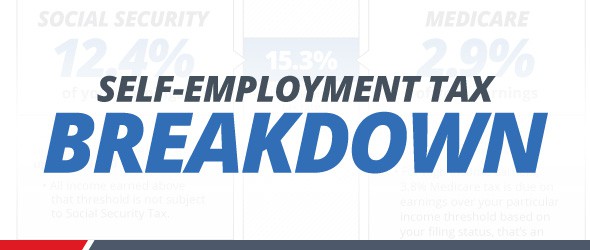Updated for tax year 2022.
No matter what self-employment looks like for you, you’re responsible for ensuring the taxes on your net earnings are paid to the Internal Revenue Service (IRS). And the self-employment tax (SE tax) is part of that.
Officially known as the Self-Employment Contributions Act tax, the SE tax is the self-employed community’s version of the taxes paid by employers and their employees for Social Security and Medicare.
Whether you run a bakeshop on the weekends, author blog posts as a freelance writer, or design logos for local businesses, you should know how the SE tax impacts your money. Let’s go over how to calculate the tax on your self-employment income.
Self-employment tax breakdown
Self-employment tax is split between two parts: Social Security and Medicare. It equals 15.3% of your self-employment earnings.
Social Security
The Social Security tax rate is 12.4 percent of your self-employment earnings. Social Security taxes must be paid on all earned income up to $127,200. All income earned above that threshold is not subject to Social Security tax.
Medicare
The Medicare tax rate is 2.9 percent of your self-employment earnings. Medicare has no earnings limit, so all earned income is taxed. For high-income earners, 3.8 percent Medicare tax is due on earnings over your particular income threshold based on your filing status—that’s an additional 0.9 percent.
Who is required to pay SE tax?
Here are some examples of who needs to pay SE tax:
• Sole proprietors of a business or trade
• Independent contractors and freelancers
• Members of a partnership of a trade or business
Even if you are traditionally employed and earn self-employment income on the side, you’re still likely required to pay SE tax on your side hustle earnings.
Steps to calculate self-employment tax
Ready to calculate how much self-employment tax you could owe this year? Let’s dive in.
Step 1: Calculate how much of your net income is taxable.
To do this, multiply your total self-employment net income by 92.3 percent (0.9235). This is the percentage of your income that the IRS says is taxable.
For example, if you earned $100,000 in self-employment income during the year, you would multiply that number by 0.9235 to determine that your taxable net income is $92,350.
Step 2: Calculate the amount you owe for self-employment taxes.
To do so, you multiply your total self-employed taxable income by 15.3 percent (0.153). Remember, the 15.3 percent is the combined percentage for Social Security and Medicare taxes.
Continuing the example above, you would take the first number you got when determining your net taxable income ($92,350) and multiply it by 0.153. In this instance, the total SE tax owed would be $14,129.55.
Step 3: Report half of your self-employment tax as an adjustment to income on your tax return (Form 1040).
Your total SE tax is reported on Form 1040 in the “Other Taxes” section. You can claim 50 percent of self-employment tax owed as a tax deduction. This reduces your adjusted gross income (AGI) and the amount of income tax you owe.
Following our previous example, you’d take the number you got in step two ($14,129.55) and multiply it by 50 percent (0.5). In this instance, your reported adjustment to income would be $7,064.78.
